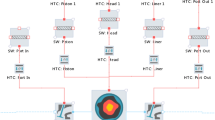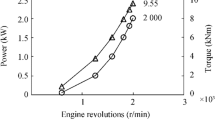Abstract
The digital twin concept proves to be highly advantageous for smart ships as it allows the digital model to adapt in real time with changes in the physical ship. The mean value engine model (MVEM) is investigated with three different compressor mass flow rate models: a 2D interpolation model (2D), an experience-based M-JENSEN (MJ) model, and a physics-based Kang Song (KS) model. Each model is studied on a MAN 7S80ME engine with ABB A270 turbochargers. The root-mean-square errors (RMSE) for the test data are approximately 2.5 \({\mathrm{m}}^{3}/\mathrm{s}\) for the 2D model, 2.8 \({\mathrm{m}}^{3}/\mathrm{s}\) for the KS model, and 0.56 \({\mathrm{m}}^{3}/\mathrm{s}\) for the MJ model. For the training data, the RMSEs are around 0.0, 3.0, and 0.69 \({\mathrm{m}}^{3}/\mathrm{s}\), respectively. When coupling each model to the MVEM, it is observed that the calculated values differ only in the turbocharger speed. The RMREs under steady-state processes are 0.54% for MVEM with the 2D model, 1.63% for MVEM with the KS model, and 0.48% for MVEM with the MJ model. Under dynamic processes where the engine load is changed from 100% to 80%, the RMREs are 1.59%, 2.40%, and 1.58%, respectively. Among the studied models, the 2D model exhibits instability, the MJ model shows the highest accuracy, while the KS model performs the worst. However, all models demonstrate comparable results when used in the MVEM. Moreover, the physics-based KS model is a favorable choice for digital twin applications due to its excellent extrapolation ability and low dependence on measured data.













Similar content being viewed by others
Data availability
The test data has been provided in the figures.
References
Mousavi S, Nejat A, Alaviyoun SS, Nejat M (2021) An integrated turbocharger matching program for internal combustion engines. J Appl Fluid Mech 14:1209–1222
Mizythras P, Boulougouris E, Theotokatos G (2021) A novel objective oriented methodology for marine engine-turbocharger matching. Int J Engine Res 23(12):2105–2127
Wang QP, Yao HM, He YH, Yu YH, Yang JG (2021) Research on rail pressure control of high-pressure common rail system for marine diesel engine based on controlled object model. IEEE Access 9:125384–125392
Tang HY, Copeland C, Akehurst S, Brace C, Davies P, Pohorelsky L et al (2017) A novel predictive semi-physical feed-forward turbocharging system transient control strategy based on mean-value turbocharger model. Int J Engine Res 18:765–775
Bolbot V, Trivyza NL, Theotokatos G, Boulougouris E, Rentizelas A, Vassalos D (2020) Cruise ships power plant optimisation and comparative analysis. Energy 196:117061
Ayad S, Vago CL, Belchior CRP, Sodre JR (2021) Cylinder pressure based calibration model for engines using ethanol, hydrogen and natural gas as alternative fuels. Energy Rep 7:7940–7954
Gooding WJ, Meier MA, Key NL (2021) The impact of various modeling decisions on flow field predictions in a centrifugal compressor. J Turbomach Trans ASME. https://doi.org/10.1115/1.4050674
Taylor AH, Odstrcil TE, Ramesh AK, Shaver GM, Koeberlein E, Farrell L et al (2021) Model-based compressor surge avoidance algorithm for internal combustion engines utilizing cylinder deactivation during motoring conditions. Int J Engine Res 22:1357–1366
Salameh G, Goumy G, Chesse P (2021) Water cooled turbocharger heat transfer model initialization: turbine and compressor quasi-adiabatic maps generation. Appl Therm Eng 185:116430
Zhu ZN, Liang K, Li ZH, Jiang HY, Meng ZW (2021) A numerical model of a linear compressor for household refrigerator. Appl Therm Eng 198:117467
Kristoffersen TT, Holden C (2021) Modeling and control of a wet-gas centrifugal compressor. IEEE Trans Control Syst Technol 29:1175–1190
Khaljani M, Vennard A, Harrison J, Surplus D, Murphy A, Mahmoudi Y (2021) Experimental and modelling analysis of efficiency enhancement in a liquid piston gas compressor using metal plate inserts for compressed air energy storage application. J Energy Storage 43:103240
Ahsan N, Al Rashid A, Zaidi AA, Imran R, Qadir SA (2021) Performance analysis of hydrogen fuel cell with two-stage turbo compressor for automotive applications. Energy Rep 7:2635–2646
Llamas X, Eriksson L (2017) Parameterizing compact and extensible compressor models using orthogonal distance minimization. J Eng Gas Turbines Power Trans ASME. https://doi.org/10.1115/1.4034152
Li X, Yang CL, Wang YY, Wang HC, Zu XH, Sun YR et al (2018) Compressor map regression modelling based on partial least squares. Roy Soc Open Sci 5:172454
Hu JW, Liu HR, Wang YG, Chen WX, Ma Y (2021) Reduced order model for unsteady aerodynamic performance of compressor cascade based on recursive RBF. Chin J Aeronaut 34:341–351
Ying YL, Xu SY, Li JC, Zhang B (2020) Compressor performance modelling method based on support vector machine nonlinear regression algorithm. Roy Soc Open Sci 7:191596
Sakellaridis NF, Raptotasios SI, Antonopoulos AK, Mavropoulos GC, Hountalas DT (2015) Development and validation of a new turbocharger simulation methodology for marine two stroke diesel engine modelling and diagnostic applications. Energy 91:952–966
Song K, Zhao B, Sun H, Yi WL (2019) A physics-based zero-dimensional model for the mass flow rate of a turbocharger compressor with uniform/distorted inlet condition. Int J Engine Res 20:624–639
De Bellis V, Bontempo R (2018) Development and validation of a 1D model for turbocharger compressors under deep-surge operation. Energy 142:507–517
Borovkov A, Galerkin Y, Petukhov E, Drozdov A, Yadikin V, Rekstin A et al (2022) CFD researches of centrifugal compressor stage vane diffusers in interests of math modeling. Int J Adv Manuf Technol 118:1–13
Serrano JR, Garcia-Cuevas LM, Inhestern LB, Guilain S, Tartoussi H (2018) Analysis of unsteady energy fluxes in a turbocharger by using a holistic model extrapolating standard lookup tables in full engine operating map. In: ASME turbo expo: turbomachinery technical conference and exposition. Oslo, Norway
McMullen R, Pino Y (2018) Conditioning turbocharger compressor map data for use in engine performance simulation. SAE Int J Engines 11:491–507
Jensen J, Kristensen A, Sorenson S, Houbak N (1991) Mean value modeling of a small turbocharged diesel engine. SAE Technical Paper 910070
Karlsen AT (2012) On modeling of a ship propulsion system for control purposes. Norwegian University of Science and Technology, Norwegian
Tsoutsanis E, Meskin N, Benammar M, Khorasani K (2014) A component map tuning method for performance prediction and diagnostics of gas turbine compressors. Appl Energy 135:572–585
Leufven O, Eriksson L (2016) Measurement, analysis and modeling of centrifugal compressor flow for low pressure ratios. Int J Engine Res 17:153–168
Sun S, Wang ZP, Sun XP, Zhao HL, Wang ZP (2021) An adaptive compressor characteristic map method based on the Bezier curve. Case Stud Therm Eng 28:101512
Yazar I, Yavuz HS, Yavuz AA (2017) Comparison of various regression models for predicting compressor and turbine performance parameters. Energy 140:1398–1406
Faltin Z, Beneda K (2020) Establishment of meanline compressor mathematical model with active blade load distribution control. In: 18th IEEE world symposium on applied machine intelligence and informatics (SAMI). IEEE, Herlany, Slovakia, pp 63–68
Grapow F, Liskiewicz G (2020) Study of the Greitzer model for centrifugal compressors: variable L-c parameter and two types of surge. Energies 13:6072
Powers KH, Kennedy IJ, Brace CJ, Milewski PA, Copeland CD (2021) Development and validation of a model for centrifugal compressors in reversed flow regimes. J Turbomach Trans ASME. https://doi.org/10.1115/1.4050668
Powers KH, Brace CJ, Budd CJ, Copeland CD, Milewski PA (2020) Modeling axisymmetric centrifugal compressor characteristics from first principles. J Turbomach Trans ASME. https://doi.org/10.1115/1.4047616
Xu PC, Zou ZP, Xuan LM (2021) A hybrid performance prediction method for centrifugal compressors based on single-zone and two-zone models. Aerosp Sci Technol 108:106358
Zhang XL, Li LW, Zhang TH (2022) Research on real-time model of turboshaft engine with surge process. Appl Sci Basel 12:744
Pulpeiro Gonzalez J, Hall C (2018) Equation-based compressor and turbine modeling for variable geometry turbochargers. SAE International, USA
Serrano JR, Arnau FJ, Gonzalez L, Gomez-Vilanova A, Guilain S (2018) Impact of a holistic turbocharger model in the prediction of engines performance in transient operation and in steady state with LP-EGR. In: ASME internal combustion engine fall technical conference, San Diego, CA
Shen HS, Zhang C, Zhang JD, Yang BC, Jia BZ (2020) Applicable and comparative research of compressor mass flow rate and isentropic efficiency empirical models to marine large-scale compressor. Energies 13:1–47
Kaechele A, Chiodi M, Bargende M (2018) Virtual full engine development: 3D-CFD simulations of turbocharged engines under transient load conditions. SAE Int J Engines 11:697–713
Yang B, Fang XD, Zhang LS, Zhuang FT, Bi MH, Chen C et al (2019) Applicability of empirical models of isentropic efficiency and mass flow rate of dynamic compressors to jet engines. Prog Aerosp Sci 106:32–42
Fang XD, Chen WW, Zhou ZR, Xu Y (2014) Empirical models for efficiency and mass flow rate of centrifugal compressors. Int J Refrigeration Rev Int Du Froid 41:190–199
Guzzella L, Onder CH (2010) Introduction to modeling and control of internal combustion engine systems. Springer, New York
Martin G (2010) 0D–1D modeling of the airpath of IC engines for control purposes. Université D’Orléans, France
Moraal PE, Kolmanovsky I (1999) Turbocharger modeling for automotive control applications. SAE Trans. https://doi.org/10.4271/1999-01-0908
Acknowledgements
The authors would like to thank Dr. Haosheng Shen for the inspiring discussions on the characteristics of the existing compressor models and for providing the data sets. Also, thanks to the reviewers for their valuable and specialized suggestions and rigorous academic attitude.
Funding
The authors disclosed receipt of the following financial support for the research, authorship, and/or publication of this article: this work was supported by National Natural Science Foundation of China (52071090), China Postdoctoral Science Foundation (2021M690495), National Key R&D Program of China (2022YFB4301400), and High-Technology Ship Research Program (CBG3N21-3-3).
Author information
Authors and Affiliations
Corresponding author
Ethics declarations
Conflict of interest
The authors declare no potential conflicts of interest with respect to the research, authorship, and/or publication of this article.
Additional information
Publisher's Note
Springer Nature remains neutral with regard to jurisdictional claims in published maps and institutional affiliations.
About this article
Cite this article
Tang, Y., Xia, Y., Zhang, J. et al. The accuracy of the mean value engine model affected little by the accuracy of compressor mass flow rate model for a marine diesel engine. J Mar Sci Technol 29, 1–19 (2024). https://doi.org/10.1007/s00773-023-00971-4
Received:
Accepted:
Published:
Issue Date:
DOI: https://doi.org/10.1007/s00773-023-00971-4




